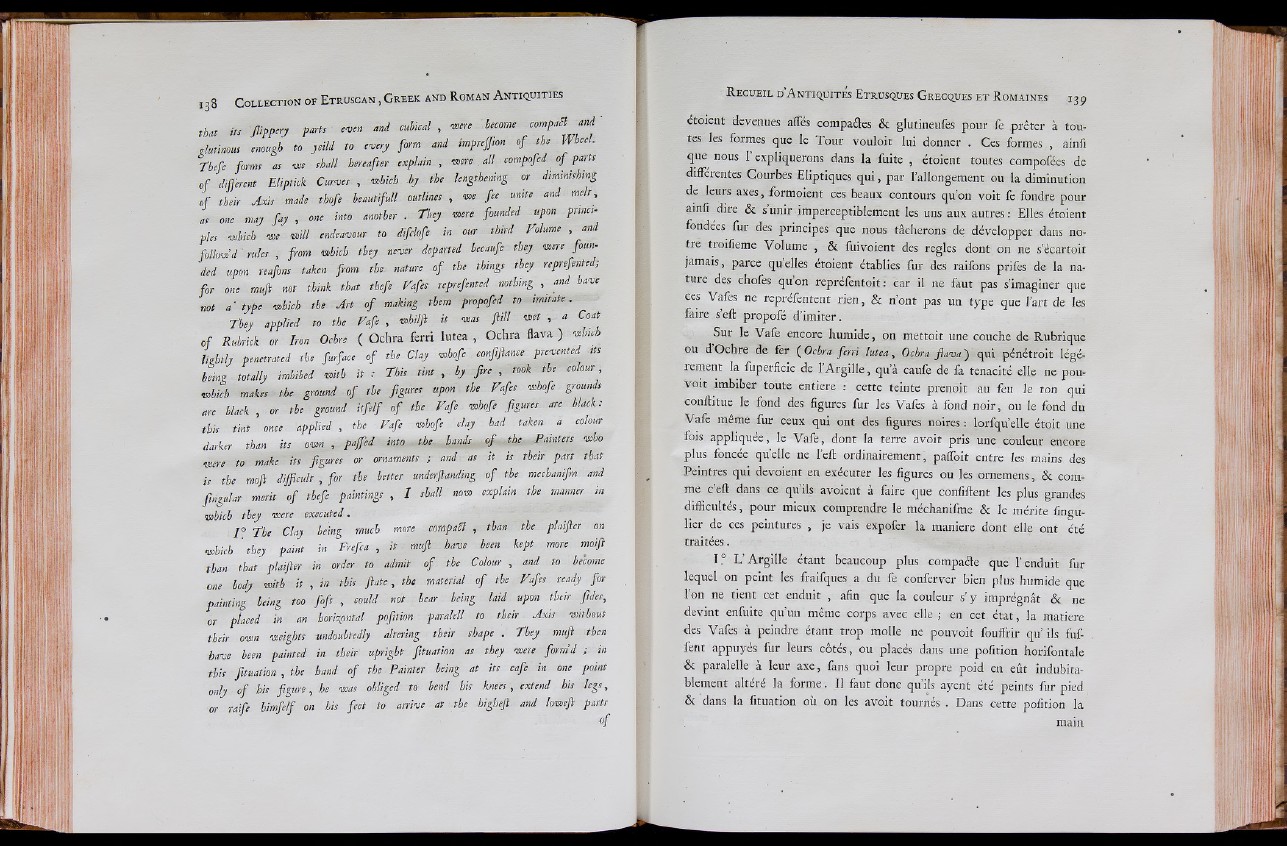
m; 7
Hill
H 'â
1
that itt Jlippcry parts even and cu b ica l, were b e c o m e compaB a n d '
glutinous enough to y cild to every form and imprcffion o f the Wheel.
Thefe forms as we shall hereafter explain , were all compofed o f parts
o f different E lip tk k Curves , which by the lengthening or dimimshmg
o f tbeir A x is made thofe bcautifull outlines , wc fe e unite and melt,
as one may fay , one into another . th e y were founded upon pr.ncipics
which wc will endeavour to difckfc in our third Volume , and
follow’d rules , from which they never departed bccaufc they were founded
upon reafons taken from the nature o f the things they reprefented;
fo r one muft not think that thcfc Vafes reprefented nothing , and have
not a- type which the A r t o f making them propofed to smitatc.
They applied to the Vafe , whilft it was f t i ll wet , a Coat
o f Ruhrick or Iron Ochrc ( Ochra ferri lutea , Ochra flava ) which
lightly penetrated the furfacc o f the Clay whofe conftftancc prevented its
being totally imbibed with it : th i s tint , by fir e , took the colour
which makes the ground o f the figures upon the Vafes whofe grounds
arc black , or the ground it f e l f o f the Vafe whofe figures arc black:
this tint once applied , the Vafe whofe clay had taken a colour
darker than its own , paffed into the hands o f the Painters who
were to make its figures or ornaments ; and as it is their part that
is the moft difficult , fo r the better underftanding o f the mechanifm and
fingular merit o f tbefe paintings , I shall now explain the manner in
which they were executed.
r The Clay Icing much more compaB , than the plaiftcr on
which 'they paint in Frefca , it muft have been kept more moift
than that plaiftcr in order to admit o f the Colour , and to become
one body with it , in this f t a t e , the material o f the Vafes ready for
painting Icing too fo ft , could not bear being laid upon tbeir fides,
or placed in an horizontal pofition paralell to tbeir A x is without
their own weights undoubtedly altering their shape . They muft then
have been painted in their upright fituation as they were form’d ; in
this fituation , the band o f the Painter being at its eafe in one point
only o f his fig u r e , he was obliged to bend his knees, extend his legs,
or raife h imfelf on his fe e t to arrive at the higheft and loweft parts
o f
etoient devenues aiTés compares & glutineufes pour fe prêter à toutes
les formes que le Tour vouloit lui donner . Ces formes , ainfi
que^ nous l’ expliquerons dans la fuite , étoient toutes compofées de
différentes Courbes Eliptiques qui, par l’allongement ou la diminution
de leurs axes, formoient ces beaux contours qu’on voit fe fondre pour
ainfi dire & s unir imperceptiblement les uns aux autres ; Elles étoient
fondées fur des principes que nous tâcherons de développer dans notre
troifieme Volume , & fulvoient des regies dont on ne s’écartoit
jamais, parce quelles étoient établies fur des raifons prifes de la nature
des chofes quon repréfentoit : car il ne faut pas s’imaginer que
ces Vafes ne repréfentent rien, & n’ont pas un type que l’art de les
faire s’efl: propofé d’imiter.
Sur le Vafe encore humide, on mettoit une couche de Rubrique
ou dOchre de fer (Ochra ferri lu tea, Ochra f ia v a ) qui pénétroit légèrement
la fuperficie de l’Argille, qu’à caufe de fa ténacité elle ne pouvoit
imbiber toute entiere ; cette teinte prenoit au feu le ton qui
conftitue le fond des figures fur les Vafes à fond noir, ou le fond du
Vafe même fur ceux qui ont des figures noires : lorfqu’elle étoit une
fois appliquée, le Vafe, dont la terre avoit pris une couleur encore
plus foncée quelle ne l’eft ordinairement, palfoit entre le s mains des
Peintres qui devoient en exécuter les figures ou les ornemens, & comme
c’eft dans ce qu’ils avoient à faire que confiftent les plus grandes
difficultés, pour mieux comprendre le méchanifme & le mérite fingulier
de ces peintures , je vais expofer la maniéré dont elle ont été
traitées.
1 ° L’ Argille étant beaucoup plus compare que f enduit fur
lequel on peint les fraifqiies a du fe conferver bien plus humide que
l’on ne tient cet enduit , afin que la couleur s’ y imprégnât & ne
devint enfuite qu’un même corps avec elle ; en cet état, la matière
des Vafes à peindre étant trop molle ne pouvoit fouffrir qu’ ils fuf-
fent appuyés fur leurs côtés, ou placés dans une pofition horifontale
& paralelle à leur axe, fans quoi leur propre poid en eût indubitablement
altéré la forme. Il faut donc qu’ils ayent été peints fur pied
& dans la fituation où on les avoit tournés . Dans cette pofition la
main